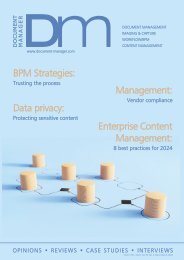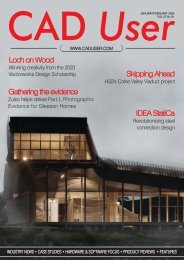CU Jul-Aug 2020
You also want an ePaper? Increase the reach of your titles
YUMPU automatically turns print PDFs into web optimized ePapers that Google loves.
SOFTWAREfocus<br />
Motion control<br />
Oasys has added social distancing to the capabilities of the agents of its pedestrian simulation<br />
application MassMotion, making it much easier for organisations to conduct proximity analyses<br />
The social habits of a lifetime are<br />
disintegrating as we learn how to<br />
weather and survive the<br />
coronavirus pandemic. As it appears<br />
that the Covid-19 virus is mainly<br />
contracted by aerosol transmission<br />
from the mouth, the natural means of<br />
mitigating its effect is through face<br />
masks and social distancing.<br />
Face masks have long been seen as<br />
acceptable in many Asian countries, but<br />
in the west there are problems of<br />
acceptable freedoms and<br />
embarrassment to overcome. Allied with<br />
a measure of social distancing, though,<br />
where both practices have been carried<br />
out, the severity of the pandemic has<br />
declined. In contrast, exemplified by the<br />
overcrowded conditions of the garment<br />
factories in Leicester and the lack of<br />
personal protection for the workers, the<br />
pandemic has run rife.<br />
We may be inching towards the end of<br />
this outbreak but are fearful of another<br />
wave succeeding the first. Lessons<br />
being learned need to be acted on now<br />
and for the future, and companies<br />
wishing to provide greater safety for<br />
their staff, or organisations which see<br />
substantial footfall through their<br />
premises, need a tool that allows them<br />
to plan office layouts for a general<br />
return to work, or to maximise the<br />
throughput of their premises with<br />
effective pedestrian corridors.<br />
Oasys MassMotion has been used by<br />
many organisations to help the design<br />
and layout of pedestrian intensive<br />
buildings, stations and venues, using<br />
intelligent 'agents' that can respond in<br />
real-time to building layouts and the<br />
actions of other agents, so it was<br />
perhaps inevitable that Oasys would<br />
also turn their attention to a further<br />
constraint - namely the imposition of<br />
social distancing.<br />
The UK Government is urging people<br />
to return to working in offices - although<br />
many of us, having had to work from<br />
home, have now discovered its benefits,<br />
in that you can still be productive<br />
without the hassle of long and<br />
expensive commutes into the city. This<br />
actually assists large city-based offices<br />
in accommodating fewer staff more<br />
safely, and allows transport companies<br />
to encourage smaller numbers of<br />
expected passengers to use socially<br />
distanced channels. It also helps them<br />
to plan to ramp up to higher occupancy<br />
and throughput as the general<br />
populations natural fears decline.<br />
OASYS MASSMOTION<br />
Oasys MassMotion uses the BIM<br />
capabilities of a 3D building model - for<br />
example of an airport, station, stadium<br />
as or office block - to simulate the<br />
throughput of pedestrians during any<br />
type of scenario, from boarding a train<br />
to escaping from a hazardous event.<br />
Individual pedestrian agents, which are<br />
given tasks to perform such as moving<br />
from entrance A to Exit B, are<br />
programmed to recognise the<br />
behaviour of other agents and respond<br />
to the possible actions of those whose<br />
path will interact with theirs.<br />
Now that we are all being asked to<br />
accommodate new or future social<br />
distancing rules, Oasys MassMotion<br />
provides organisations with a highly<br />
focused set of tools that can produce<br />
detailed comparisons of different office<br />
schemes or pedestrian guidelines.<br />
Architects who are already using the<br />
software will be delighted to discover<br />
that they can use it to comply with both<br />
capacity rules and the government's<br />
safety guidelines.<br />
12<br />
<strong>Jul</strong>y/<strong>Aug</strong>ust <strong>2020</strong>

















